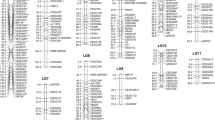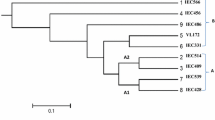Abstract
Using an F2 population derived from cultivated and wild azuki bean, we previously detected a reciprocal translocation and a seed size QTL near the translocation site. To test the hypothesis that the translocation in the cultivated variety contributed to the larger seed size, we performed further linkage analyses with several cross combinations between cultivated and wild azuki beans. In addition, we visually confirmed the translocation by cytogenetic approach using 25 wild and cultivated accessions. As a result, we found the translocation-type chromosomes in none of the cultivated accessions, but in a number of the wild accessions. Interestingly, all the wild accessions with the translocation were originally collected from East Japan, while all the accessions with normal chromosomes were from West Japan or the Sea of Japan-side region. Such biased geographical distribution could be explained by the glacial refugium hypothesis, and supported narrowing down the domestication origin of cultivated azuki bean.




Similar content being viewed by others
References
Chaiteng B, Kaga A, Tomooka N, Isemura T, Kuroda Y, Vaughan DA (2006) Development of a black gram [Vinga mungo (L.) Hepper] linkage map and its comparison with an azuki bean [Vigna angularis (Willd.) Ohwi and Ohashi] linkage map. Theor Appl Genet 113:1261–1269
Han OK, Kaga A, Isemura T, Wang XW, Tomooka N, Vaughan DA (2005) A genetic linkage map of azuki bean [Vigna angularis (Willd.) Ohwi and Ohashi]. Theor Appl Genet 111:1278–1287
Hewitt GM (1996) Some genetic consequences of ice ages, and their role in divergence and speciation. Biol J Linn Soc 58:247–276
Hewitt GM (2000) The genetic legacy of the Quaternary ice ages. Nature 405:907–913
Honjo M, Ueno S, Tsumura Y, Washitani I, Ohsawa R (2004) Phylogeographic study based on intraspecific sequence variation of chloroplast DNA for the conservation of genetic diversity in the Japanese endangered species Primula sieboldii. Biol Conserv 120:211–220
Isemura T, Kaga A, Tomooka N, Shimizu T, Vaughan DA (2010) The genetics of domestication of rice bean, Vigna umbellata. Ann Bot 106:927–944
Isemura T, Kaga A, Tabata S, Somta P, Srivines P, Shimizu T, Jo U, Vaughan DA, Tomooka N (2012) Construction of a genetic linkage map and genetic analysis of domestication related traits in mungbean (Vigna radiata). PLoS One 7:e41304
Iwasaki T, Aoki K, Seo A, Murakami N (2012) Comparative phylogeography of four component species of deciduous broad-leaved forests in Japan based on chloroplast DNA variation. J Plant Res 125:207–221
Iwata H, Ninomiya S (2006) AntMap: constructing genetic linkage map using an ant colony optimization algorithm. Breed Sci 56:371–377
Kaga A, Isemura T, Tomooka N, Vaughan DA (2008) The genetics of domestication of the azuki bean (Vigna angularis). Genetics 178:1013–1036
Kim CG, Fujimiya A, Saitou N (2003) Construction of a gorilla fosmid library and its PCR screening system. Genomics 82:571–574
Liu CJ, Witcombe JR, Pittaway TS, Nash M, Hash CT, Busso CS, Gale MD (1994) An RFLP-based genetic map of pearl millet Pennisetum glaucum. Theor Appl Genet 89:481–487
Livingstone KD, Churchill G, Jahn MK (2000) Linkage mapping in populations with karyotype rearrangements. J Hered 91:423–428
Qi X-S, Chen C, Comes HP, Sakaguchi S, Liu Y-H, Tanaka N, Sakio H, Qiu Y-X (2012) Molecular data and ecological niche modelling reveal a highly dynamic evolutionary history of the East Asian Tertiary relict Cercidiphyllum (Cercidiphyllaceae). New Phytol 196:617–630
Scriven PN, Handyside AH, Ogilvie CM (1998) Chromosome translocations: segregation modes and strategies for preimplantation genetic diagnosis. Prenat Diagn 18:1437–1449
Somta P, Kaga A, Tomooka N, Kashiwaba K, Isemura T, Chaitieng B, Srivines P, Vaughan DA (2006) Development of an interspecific Vigna linkage map between V. umbellata (Thunb.) Ohwi and Ohashi and V. nakashimae (Ohwi) Ohwi and Ohashi and its use in analysis of bruchid resistance and comparative genomics. Plant Breed 125:77–84
Takeya M, Yamasaki F, Uzuhashi S, Aoki T, Sawada H, Nagai T, Tomioka K, Tomooka N, Sato T, Kawase M (2011) NIASGBdb: NIAS Genebank databases for genetic resources and plant disease information. Nucleic Acids Res 39:1108–1113
Tateishi Y, Maxted N (2002) New species and cobinations in Vigna subgenus Ceratotropis (Piper) Verdcourt (Leguminosae, Phaseoleae). Kew Bull 57:625–633
Tomooka N (2007) Archaeological remains of azuki bean (Vigna angularis). Google map. https://www.google.co.jp/url?sa=t&rct=j&q=&esrc=s&source=web&cd=1&cad=rja&uact=8&ved=0CCEQFjAA&url=https%3A%2F%2Fmaps.google.co.jp%2Fmaps%2Fms%3Fgl%3Djp%26ie%3DUTF8%26oe%3DUTF8%26msa%3D0%26msid%3D200493098808611613389.000001124500bf8f41d2b&ei=wy_oU6OUKc_q8AXL8oGICg&usg=AFQjCNEQouz_ye4sl5rTLGnI8WwA96_wsw&sig2=o19jRgtmrxa6zufQXKcYZA&bvm=bv.72676100,d.dGc
Tomooka N, Kaga A, Vaughan DA (2005) The Asian Vigna (Vigna subgenus Ceratotropis): Biodiversity and evolution. In: Sharma AK, Sharma A (eds) Plant genome: biodiversity and evolution, vol 1c., PhanerogamsScience, Enfield, pp 87–147
Vaughan DA, Tomooka N, Kaga A (2005) Azuki bean [Vigna angularis (L.) Ohwi and Ohashi]. In: Singh RJ, Jauhar PP (eds) Genetic resources, chromosome engineering, and crop improvement, vol 1., Grain legumesCRC Press, Boca Roca, pp 341–353
Wang XW, Kaga A, Tomooka N, Vaughan DA (2004) The development of SSR markers by a new method in plants and their application to gene flow studies in azuki bean [Vigna angularis (Willd.) Ohwi and Ohashi]. Theor Appl Genet 109:352–360
Wang S, Kakui H, Kikuchi S, Koba T, Sassa H (2012) Interhaplotypic heterogeneity and heterochromatic features may contribute to recombination suppression at the S locus in apple (Malus × domestica). J Exp Bot 63:4983–4990
Wiman KG, Clarkson B, Hayday AC, Saito H, Tonegawa S, Hayward WS (1984) Activation of a translocated c-myc gene: role of structural alterations in the upstream region. Proc Natl Acad Sci USA 81:6798–69802
Xu HX, Jing T, Tomooka N, Kaga A, Isemura T, Vaughan DA (2008) Genetic diverisity of the azuki bean (Vigna angularis (Willd.) Ohwi and Ohashi) gene pool as assessed by SSR markers. Genome 51:728–738
Yamaguchi H (1992) Wild and weed azuki beans in Japan. Econ Bot 46:384–394
Yamamoto Y, Sano CM, Tatsumi Y, Sano H (2006) Field analysis of horizontal gene flow among Vigna angularis complex plants. Plant Breed 125:156–160
Acknowledgments
We are very grateful to Dr. Takaya Iwasaki for his academic adivice about glacial refugium hypothesis. We are also grateful to Hokkaido Prefectural Central Agricultural Experiment Station for supplying seeds of a cultivar ‘Shumari’. This research was partially conducted while the first author was a visiting scholar in NIAS.
Conflict of interest
The authors declare no conflict of interest.
Author information
Authors and Affiliations
Corresponding author
Electronic supplementary material
Below is the link to the electronic supplementary material.
Rights and permissions
About this article
Cite this article
Wang, L., Kikuchi, S., Muto, C. et al. Reciprocal translocation identified in Vigna angularis dominates the wild population in East Japan. J Plant Res 128, 653–663 (2015). https://doi.org/10.1007/s10265-015-0720-0
Received:
Accepted:
Published:
Issue Date:
DOI: https://doi.org/10.1007/s10265-015-0720-0




